 The vibe ace might have dedicated this set to Gary Burton, but he tips the cap to Bobby Hutcherson as well. And he probably has Milt Jackson in the back of his mind. A different sounding set that what he’s turned in on past dates, Gillece is in command of his ax as well as his position as a leader. Quite an engaging date that’s a real tonic for jaded (Tjaded?) ears, this is a swell serving of mighty fine sitting down jazz sure to get you shaking in your seat. Well done throughout.
The vibe ace might have dedicated this set to Gary Burton, but he tips the cap to Bobby Hutcherson as well. And he probably has Milt Jackson in the back of his mind. A different sounding set that what he’s turned in on past dates, Gillece is in command of his ax as well as his position as a leader. Quite an engaging date that’s a real tonic for jaded (Tjaded?) ears, this is a swell serving of mighty fine sitting down jazz sure to get you shaking in your seat. Well done throughout.
Category: Reviews
Smooth Technique and a love of Melody is “Bright Side” by Doug Webb
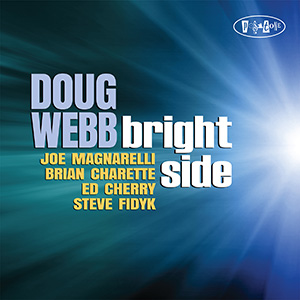 From the very first, sweet strains of tenor saxophone that leap from my CD player, I know it’s Doug Webb. I’ve been listening to his style and enjoying the excitement he creates on stage for three decades. Webb has been featured on over 150 jazz recordings and has added his blues soaked style to tracks used in hundreds of television programs and movies. He’s an on-demand, Southern California, saxophone session man for television and film. This, his seventh album release, is funk-based with Manarelli on trumpet blending well with Webb’s saxophone licks. Webb has penned seven out of the twelve songs on this CD. His composition skills showcase smooth technique and a love of melody. The addition of Charette on organ spices things up and thickens the stew when Webb puts the pots on to boil. This is particularly obvious on cut #3, “The Drive”, where everyone of the musicians seem powered up and propel their improvisational skills at a fast clip. I found Webb’s composition, “Melody for Margie” to be beautiful, promoting a visceral emotion. Another of his compositions I enjoyed immensely is “One For Hank” where Cherry on guitar gers to stretch out, as well as Charette on organ. All in all, this CD swings and Webb is flying above the solid rhythm section, as daring as a man on a trapeze. His music is exciting.
From the very first, sweet strains of tenor saxophone that leap from my CD player, I know it’s Doug Webb. I’ve been listening to his style and enjoying the excitement he creates on stage for three decades. Webb has been featured on over 150 jazz recordings and has added his blues soaked style to tracks used in hundreds of television programs and movies. He’s an on-demand, Southern California, saxophone session man for television and film. This, his seventh album release, is funk-based with Manarelli on trumpet blending well with Webb’s saxophone licks. Webb has penned seven out of the twelve songs on this CD. His composition skills showcase smooth technique and a love of melody. The addition of Charette on organ spices things up and thickens the stew when Webb puts the pots on to boil. This is particularly obvious on cut #3, “The Drive”, where everyone of the musicians seem powered up and propel their improvisational skills at a fast clip. I found Webb’s composition, “Melody for Margie” to be beautiful, promoting a visceral emotion. Another of his compositions I enjoyed immensely is “One For Hank” where Cherry on guitar gers to stretch out, as well as Charette on organ. All in all, this CD swings and Webb is flying above the solid rhythm section, as daring as a man on a trapeze. His music is exciting.
Dee Dee McNeil – musicalmemoirs’s blog
Step Tempest reveals the positive message in “Message In Motion”
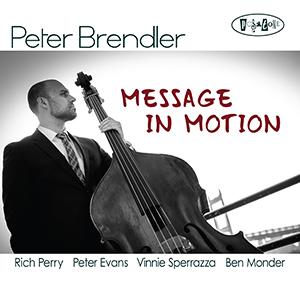 It’s no secret that as a listener and review, I’m drawn to the work of the rhythm section. Not that I don’t appreciate a great saxophonist or guitarist but it’s the response and the interaction with the people keeping the flow going that often catches my ears first.
It’s no secret that as a listener and review, I’m drawn to the work of the rhythm section. Not that I don’t appreciate a great saxophonist or guitarist but it’s the response and the interaction with the people keeping the flow going that often catches my ears first.
“Message In Motion” is bassist and composer Peter Brendler‘s second release for Posi-Tone Records (my review of the debut is here); happily, the album features the same ensemble as the first including Rich Perry (tenor saxophone), Peter Evans (trumpet) and Vinnie Sperrazza (drums). Guitarist Ben Monder joins the band on four of the 10 tracks. One of the more arresting attributes of the debut was how “open” and exploratory the music was and that carries over to this recording as well. The program starts out with a good “blues shuffle”, the front line playing a sweet theme that leads into Evans’ circular solo and into Perry’s romp while the rhythm section keeps the motor running (though pay attention to how Brendler switches for “walking lines” to playing counterpoint. The playfulness of the bassist’s infectiousness “Angelica” and it’s a Sonny Rollins-like romp that features smart interactions between the bassist and Sperrazza. You can feel the spirit of playfulness on the swinging “Very Light And Very Sweet” and also on the Clifford Brown-like feel on “Didn’t Do Nothing.” While Brendler and Sperrazza “dance” around underneath, Perry and Evans build sparkling solos on both tracks.
The other “non-original” on the album is a playful rendition of Alice Coltrane’s “Ptah the El Daoud” – Sperrazza’s marching drums and Brendler’s “oom-pah” bass lines accompany the front line as they read through the theme. The piece opens up in subtle ways as the bass expands on its rhythmic approach and the drums interacts with Perry on his expansive explorations. Evans goes “out” a little further with a series of spurts and sputters in the midst of his while the rhythm section continues to push forward. The blend of traditional rhythms and exploratory, even noisy, solos is a highlight of the recording.
Come to “Message In Motion” with open ears and open mind; you will not be disappointed. The music that Peter Brendler creates with Rich Perry, Peter Evans, Vinnie Sperrazza, and Ben Monder is lively, thoughtful, playful, exciting, and smart. This fine album makes one wish to see and hear this group live.
Richard B. Kamins – Step Tempest
Midwest Record joins the “Allied Forces” by Steve Fidyk
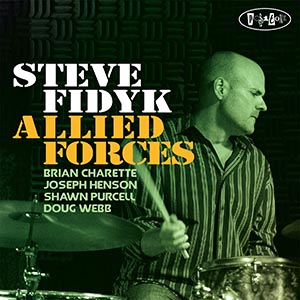 Straight ahead swinging jazz powered by a crew of leaders in their own rights, drummer Fidyk makes no statements here other than he can keep things on track from the back of the stage and that good are meant to be shared by all. Not the kind of feel good jazz you’d associate with water front bars on summer nights but you have to call it that for lack of a better name, this is smoking stuff that works throughout and is the kind of friendly hard core jazz that brings new listeners into the tent despite themselves. On the money throughout and totally hot.
Straight ahead swinging jazz powered by a crew of leaders in their own rights, drummer Fidyk makes no statements here other than he can keep things on track from the back of the stage and that good are meant to be shared by all. Not the kind of feel good jazz you’d associate with water front bars on summer nights but you have to call it that for lack of a better name, this is smoking stuff that works throughout and is the kind of friendly hard core jazz that brings new listeners into the tent despite themselves. On the money throughout and totally hot.
Chris Spector – Midwest Record
“Once & Future” by Brian Charette gets praised by Something Else
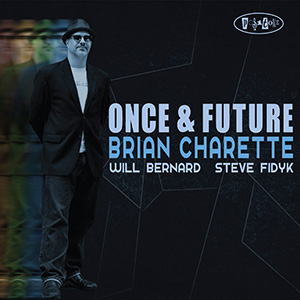 While unboxing guitarist Will Bernard’s delightful latest offering Out & About a few months ago, it was impossible not to rave on the key contributions of his combo’s organist Brian Charette. Charette has regularly put in stellar supporting roles whether it’s for Posi-Tone Records stablemates like Bernard or any jazz leader of note in need of some maximal Hammond B3.
While unboxing guitarist Will Bernard’s delightful latest offering Out & About a few months ago, it was impossible not to rave on the key contributions of his combo’s organist Brian Charette. Charette has regularly put in stellar supporting roles whether it’s for Posi-Tone Records stablemates like Bernard or any jazz leader of note in need of some maximal Hammond B3.
Once & Future (Posi-Tone, June 3, 2016) doesn’t reach for such levels of risk-taking but it does offer the occasion of hearing Charette again trading licks with Bernard, only with the leader/sideman roles reversed. No horns this time as Charette’s group is reduced to the tried-and-true organ/guitar trio (Steve Fidyk brings the drums). As a noted educator of the B3 (he writes instructional books and articles, conducts masterclasses and teaches at workshops), Once & Future can be thought of as a ‘clinic’ record where he touches on many of the various techniques of the jazz organ as well as many shades of sub-styles, from Jimmy Smith to Larry Young. In keeping, only three of these fourteen tunes are his and many of the rest might be familiar to you. They may also titillate with Charette’s manner by which he carries these songs…
S. Victor Aaron – Something Else Reviews
JazzdaGama recognizes the Zen quality of “Koan” by Spike Wilner
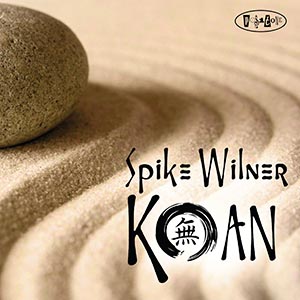 When a musician uses, in his music, ‘chance’ operations in order to free the ego from likes and dislikes, trusting that this use is comparable to sitting cross-legged with a musical-ancestor-teacher and allows the way of Zen to work it is possible that the mind not cut itself off from Mind, but let Mind flow through it. This, it would seem is the ‘koan’ that has wrought the fine music that is played by the pianist Spike Wilner on his 2016 Posi-Tone recording Koan. And in doing just that with the music he is able to let it affect his beautifully empathetic bassist Tyler Mitchell and drummer Anthony Pinciotti. This is an unambiguously beautiful performance. Clearly Wilner has developed an affinity for the piano allowing him to seek out new possibilities, thus encouraging the free spirit in him. This is still a rare thing among pianists (playing today) and we should surely welcome it.
When a musician uses, in his music, ‘chance’ operations in order to free the ego from likes and dislikes, trusting that this use is comparable to sitting cross-legged with a musical-ancestor-teacher and allows the way of Zen to work it is possible that the mind not cut itself off from Mind, but let Mind flow through it. This, it would seem is the ‘koan’ that has wrought the fine music that is played by the pianist Spike Wilner on his 2016 Posi-Tone recording Koan. And in doing just that with the music he is able to let it affect his beautifully empathetic bassist Tyler Mitchell and drummer Anthony Pinciotti. This is an unambiguously beautiful performance. Clearly Wilner has developed an affinity for the piano allowing him to seek out new possibilities, thus encouraging the free spirit in him. This is still a rare thing among pianists (playing today) and we should surely welcome it.
The repertoire that Spike Wilner plays here are a mix of his own compositions, and flamboyant bebop and familiar and exotic blues and swing, as well as contemporary standards. (I did miss Wayne Shorter’s and even a Charles Mingus or two, but that, perhaps might be grist for his grinding on another album as beautiful as this one). Nevertheless this music seems a good fit for Wilner. His agile and rock-solid finger technique means that Duke Ellington’s ‘Warm Valley’ and Tadd Dameron’s ‘Hot House’, as well as a Wilner original (pick any) can thrill as they should while never trampling on the gorgeous deep tone of the magnificently tuned piano. Yet Wilner can also find the poetic eloquence in Ornette Coleman’s ‘Lonely Woman’. The qualities with which he achieves that – an almost casually fluid approach to the rhythmic dislocation of individual lines and an ability to assume ornamentation into each of the aforementioned tunes distinguish his performance style across the range of these pieces.
In his own writing Spike Wilner reveals a strong visual imagination which likes to link these pieces to their imagined operatic doppelgängers leading one to appreciate the ‘koan’ metaphor even more so that he is right to claim this Zen quality for the extraordinary, fractured ‘Blues For The Common Man’. Wilner is also incapable of over-egging things and his unhurried freedom of momentum in his account of the said ‘Koan’ is beguiling in its simplicity as well as mesmerising in its melodic/harmonic complex. Through it all you hear the Renaissance man in the pianist through his immense musicianship that speaks his deep connection with the Ancestors. Spike Wilner has given us much with this performance and much more is expected from him in the future.
Raul da Gama – JazzdaGama
All About Jazz takes us “Out & About” by Will Bernard
 As if more proof was necessary Out & About confirms guitarist Will Bernard is as skilled a bandleader as he is an instrumentalist. And both roles require an artful approach as this album makes clear: it’s one thing to find talented musicians-as Bernard most certainly does here-it’s quite another to elicit that talent in such a way it complements the talent (and personality) of each of the other musicians involved.
As if more proof was necessary Out & About confirms guitarist Will Bernard is as skilled a bandleader as he is an instrumentalist. And both roles require an artful approach as this album makes clear: it’s one thing to find talented musicians-as Bernard most certainly does here-it’s quite another to elicit that talent in such a way it complements the talent (and personality) of each of the other musicians involved.
In this context then Out & About is a most ambitious undertaking because Bernard enlists the assistance of three other formidable musicians: drummer Allison Miller, bassist Ben Allison and saxophonist John Ellis, all with their own careers and ensembles of some note and history (and based on that reality alone, some measurable and presumably healthy ego). But the San Francisco Bay Area guitarist also demonstrates the wisdom to preserve his relationship with long-time trio partner, organist Brian Charette, who acts as a combination catalyst and bonding agent unifying this quintet for the sake of the recording.
The five-some lightheartedly dance through “Happy Belated,” illustrating the easy going interactions of which they’re capable, then spend a little less than two minutes illustrating the grace and delicacy they can create on “Not too Fancy.” And, as “Next Guest” attests, it hardly matters who’s soloing here at any give time because, even as Bernard fingers his fret board with such precision here, Allison is almost equally so on bass, never colliding with the guitarist, but acting as a counterpoint as if to highlight the leader’s skill.
The album’s longest track at 6:45, “Habanera” features Charette drawing out the melody line in an altogether luxurious pace, but that doesn’t obscure the motion of Miller at her kit: her playing is so natural, it’s vivid enough to visualize. Meanwhile, Bernard leads by example, he using sufficiently varied tones and attacks to keep himself and all involved alert in a state of positive flux. Accordingly, Ellis twists and turns playing his horn on “Redwood (Business Casual)” where everyone is quick on the uptake of each other’s ideas. The leader unwinds more fluid lines on “Pan Seared,” and the keyboardist instinctively follows suit.
All of which such interplay is especially admirable given the economy of arrangement and production (by Marc Free from one day of recording in Brooklyn) within cuts in the three-to-five minute duration range. But then what better way to illustrate the versatility of a band than for it to move quick through the various changes Bernard presents in this all-original material. His understated vigor in this musicianship on the title song and “Homebody” insinuates the sounds within the listener’ Out & About will not recede into mere background music.
Doug Collette – All About Jazz
Dusted Magazine shows us the “Bright Side” by Doug Webb
 The title of Doug Webb’s seventh Positone release sums up not only a personal outlook on his vocation, but the reality of it as well, given a career involving 30+ years as a professional musician. Bright Side teams the tenorist with some of the brightest of his immediate peers on the imprint with trumpeter Joe Magnarelli, organist Brian Charette and guitarist Ed Cherry each successful leaders in their own right. Drummer Steve Fidyk doesn’t have a session under his auspices yet, but his calendar as a sideman remains packed with cherry-picked gigs.
The title of Doug Webb’s seventh Positone release sums up not only a personal outlook on his vocation, but the reality of it as well, given a career involving 30+ years as a professional musician. Bright Side teams the tenorist with some of the brightest of his immediate peers on the imprint with trumpeter Joe Magnarelli, organist Brian Charette and guitarist Ed Cherry each successful leaders in their own right. Drummer Steve Fidyk doesn’t have a session under his auspices yet, but his calendar as a sideman remains packed with cherry-picked gigs.
As with earlier Webb dates the program draws liberally from a songbook of originals while threading in a handful of covers including the bossa nova “Bahia” and Oliver Nelson’s hardbop workhorse “The Drive”. Webb is a specialist at devising tight punchy heads that pack sizeable ensemble wallops while working flexibly as spring boards for economy-minded solos. “Society Al”, a titular riff on a Dexter Gordon composition, features his horn initially in isolation before the band arrives to advance a rolling, organ-forward groove.
“Silver Lining” gives Charette the chance to show off his skill with building swirling, descending textures as Fidyk carves out a choppy beat beside him. Magnarelli sits out leaving Webb to ride the waves through a solo ripe with both velocity and spirited inflections. Credited to someone with the surname Eastlee, “Steak Sauce” shows off the quintet’s shared facility with a boogaloo rhythm. Charette’s bass lines ooze grease and the horns lock on some lean, but tasty unisons atop another porous series of patterns from Fidyk. Cherry leans back and concerns himself with comping inventively under the frontline extemporizations before moving stepping out for a supple say of his own.
“Melody for Margie” and “One for Hank” reference more important figures in Webb’s personal history, the first at a ballad tempo that capitalize on Charette and Cherry’s capabilities at shaping amorous support lines and Fidyk’s gentle facility with brushes. The second personifies in sound a saxophonist answering to the surname Mobley, at least in general feel, as Webb glides through a set of cerulean-hued changes and into another plush-voiced solo that ranges purposefully through his horn’s middle register. Charette and Cherry also get spotlights before a group exit and the album caps off with another groove workout in the accommodating guise of Webb’s “Funky Medina”. With friends and continued opportunities like these it’s easy to see how he entertains his abiding optimism.
Derek Taylor – Dusted Magazine
New York City Jazz Record gives a great review of “Gratitude” by Tom Tallitsch
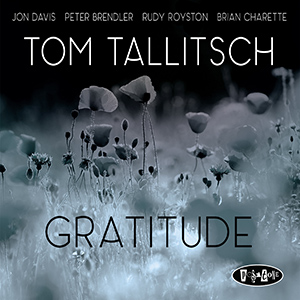 Tenor saxophonist Tom Tallitsch is an Illinois-bred,
Tenor saxophonist Tom Tallitsch is an Illinois-bred,
New Jersey-based bandleader and Gratitude is his
seventh album a leader. Tallitsch plays Straightahead
postbop, tossing a few Curve balls to keep things
interesting. He is Of the generation(s) Of players that
doesn’t rely on the Great American Songbook for
material (9 Of the 11 tracks herein are Originals) and he
dips into the rock world for inspiration.
The album opens with “Terrain”, a surging, modal
midtempo tune evoking ’70s McCoy Tyner. Tallitsch
has a notable tone—burly approach of Rollins,
flow of Dexter Gordon and cool of Lester Young, etc.—
but no one influence dominates in a fascinating blend
Of robustness and yearning. Drummer Rudy Royston
kicks up as much dust (and propulsion) as Art Blakey and Jon Davis’ piano is spare, slightly percussive (that
Tyner influence) and possessed of an easy lyricism, He and Tallitsch share a very measured approach. taking
an almost leisurely tack in constructing their solos. Fleetwood Mac’s “Gold Dust Woman” might not
seem the kind Of fare a jazz combo might tackle, but Tallitsch shows its majesty. The saxophonist invests
some elegant blues feeling into the proceedings while Davis, Royston and bassist Peter Brendler slyly add a
soul-jazz groove more implied than overt and guest Brian Charette deftly adds slightly gothic-sounding
organ. These lads close out the program with another seemingly unlikely tune, Led Zeppelin’s “Thank You”,
essayed with a gospel feel thanks to organ (especially) and Davis’ sparse, Slightly Thelonious Monk-like
Chords. Tallitsch gets to shine in a poignant manner without ever getting Cloying Or going Over the top.
Gratitude is an album that displays a rare and very engaging balance Of fervor and restraint, expressive
ace musicianship and terseness.
by Mark Keresman – New York City Jazz Record
Chance Meeting Lands Junior Role as Drummer on “Father Figure” by Michael Dease
 A UT student drummer has made his professional debut on a recently released album.
A UT student drummer has made his professional debut on a recently released album.
Luther Allison, a junior jazz student in UT’s School of Music, recently recorded on jazz trombonist Michael Dease’s newest album, Father Figure, which was released on April 22.
When one of his professors recommended him for the drummer at the Jazz Trombone Institute summer camp in Brevard, North Carolina, Allison never imagined the doors that would open for him.
“My father would always tell me ‘Always be ready because you never know when people will discover you,’” said Allison.
Dease was performing at the camp and was impressed by Allison’s talent on the drums. It was there that Dease asked Allison to perform on his album.
In early October, Allison drove eleven hours from Hess Hall to Brooklyn, New York, to meet with Dease and other professional and collegiate musicians performing on the album. They spent the following week rehearsing, recording the album, and performing shows in New York and Michigan, getting little sleep and practicing through the night.
“I was having the time of my life,” said Allison. “I was sleeping for an hour and a half or two hours a night, but my adrenaline was pumping the whole week, so missing sleep wasn’t an issue.”
“I knew right away, from his phone interview, that I was about to meet a special soul full of passion and humility,” said Dease. “After our first rehearsal I was convinced of his immense talent, which is somewhat hidden by his sincerity and maturity.”
The opportunity to record with Dease allowed Allison to showcase his skills but also taught him a valuable lesson.
“The biggest lesson I learned from this experience is to pace myself, whether it be musically or in my life in general,” said Allison. “If this is the career path I want to have in the future, I have to be in shape mentally, physically, emotionally, and professionally to keep up with the lifestyle.”
Allison is already a disciplined musician. He practices five hours a day and maintains a 3.7 grade point average. He also takes to heart the advice and constructive feedback of his professors and mentors.
“Mentorship is something I think is imperative in bringing up the next generation. In order to be able to keep tradition going, you really need your predecessors to set the tone for what you need to do in the future. Dease did an extraordinary job in taking me under his wing and introducing me to other musicians. It’s both humbling and exciting—it makes me want to work that much harder because I want to live up to his expectations,” said Allison.
Recording on Father Figure has opened academic opportunities for Allison. He plans on continuing his education in music performance, with a focus on jazz, at the master’s and doctoral levels. He wants to perform and tour early on in his career but hopes to eventually teach at a university.
“Luther did a standout job in my band,” said Dease. “I’m proud to have captured those moments forever on disc, and he brought the highest level of attention, positivity, and skill to my recording session.”
Amy Blakely